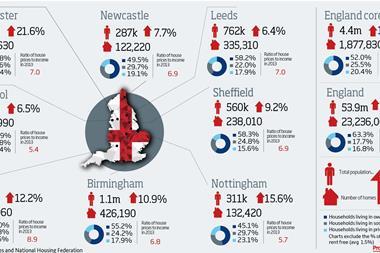All the main political parties acknowledge that the housing shortage is a threat to our economic success as well as our social cohesion.

The shortage is felt by employers who wish to retain their talented teams and by employees seeking a decent quality of life in our cities.
We compete globally for that mobile talent, so if their quality of life diminishes, their daily commute is too crowded or delayed, and their homes are too cramped or insecure, our hands will be tied.
Therefore, if London and the UK are to remain competitive, I would argue that we should aspire to solve the housing crisis not just by delivering units (essential though this is) but by creating and sustaining neighbourhoods that provide a good and growing quality of life.
These neighbourhoods should be home for all Londoners. They should be neighbourhoods that have density with liveability; high-quality amenities and public realm; strong local retail; and community leadership - residents with a say.
This is Grosvenor’s approach in the UK, through our work in London, Liverpool, Edinburgh, Oxford, Cambridge and Southampton. We want to invest, with patient capital, in vibrant, urban neighbourhoods that stand the test of time. And in doing so, we want to deliver build-for-rent homes at scale.
We are not alone. There is growing consensus that a strong private rented sector (PRS) would deliver economic and social benefits. It would provide not just a badly needed new source of supply, but when combined with other forms of housing, high-quality, long-term neighbourhoods, maintained and enhanced over time thanks to incentivised patient capital.
So what is needed to turn the tap on full for build-for-rent? There are many perspectives. Let me give two.
First, we need to remove the dead hand of planning. We know the price of sites for housing is driven by values in the build-for-sale market. We also know that viability assessments create uncertainty, especially for build-for-rent developers. In turn, they have to discount for this risk and therefore find it tough to compete for the land they need to move forward,
Policymakers need to offer developers a much clearer proposition. For example, in return for a covenant committing to PRS for, say, 20 years and perhaps longer tenancies of three years with rent indexed over this period, developers gain the benefit of a fixed, predictable and lower section 106 requirement.
The challenge facing the London boroughs in particular is exemplified by their wish to replace large mono-tenure estates with a dense, liveable mixture of housing for sale, subsidised affordable homes and - importantly - market housing for rent.
Second, I would argue that we need a beefed-up mayoral agency - a ‘Housing for London’. Giving the mayor new powers to identify and dispose of surplus public sector land has been seen as welcome progress but the next challenge is ensuring assembled sites are ready to go. If properly resourced - working with boroughs and the private sector - the mayor could assemble sites, designate use and forward-fund the necessary infrastructure - starting with the opportunity areas he has already earmarked.
The mayor could then unlock land for build-for-rent and sell to the market, plot by plot, spurring investor demand in the process.
It’s clear that the housing shortage is a big, pressing problem that requires big, bold solutions. If we’re going to meet the challenge not just with units, but also with vibrant new urban neighbourhoods, public and private sector players will to have to collaborate and show leadership in new ways.
Peter Vernon is chief executive of Grosvenor Britain & Ireland






























No comments yet